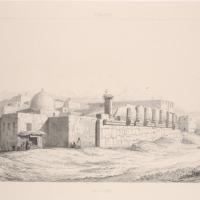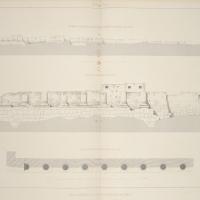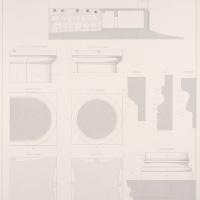The so-called Temple of Artemis-Anāhitā
Comment
In the ruins of the hillside terrace complex within the city of Kangāvar, echoes of Greco-Roman traditions in stone architecture are conveyed by the cyma reversa profile of the cornice that runs along the top of the stone retaining wall of the terrace, as well as by the forms of the bases and the square abacus of the capitals of the partly preserved colonnade resting on the cornice.
Reckoning by such 'western' features, Charles Texier (1842: II, 88-89, pl. 65) and Eugène Flandin and Pascal Coste (1851: I, 409-412, pls. 20-23bis), the first modern visitors who give a description and detailed drawings and plans of the ruins, thought they could identify this site with the temple of Artemis, which, according to the Greek geographical author Isidorus of Charax (Parthian Stations 6 [Schoff 1914]), existed in Kangāvar in the first century of our era. These initial commentaries account for the now common designation of the site as a Temple of Artemis-Anāhitā (Anāhitā being presumably the ancient Iranian equivalent of the Greek goddess Artemis). Until the 1960s, they also continued to find echoes in various tentative perceptions of the structures that once stood on the terrace as following a Greek plan —as a peripteral Greek temple surrounded by a monumental peristyle (Flandin and Coste 1851-1852: pl. 23bis; cf. Ghirshman 1962: 24 pl. 31)—, and in equally tentative attributions of the construction of the monument to the late third/second (Herzfeld 1935: 50; Godard 1962: 165; Ghirshman 1962: 24) or the first (Reuther 1938: 411; Trever 1967: 124) century BC, hence, to the Hellenistic and/or the Parthian period. (Surveys of early commentaries: Schippmann 1971: 298-308; Azarnoush 1981: 69-71.)
Excavations and restoration work undertaken at the site since 1968 variously exposed the difficulties that stand in the way of obtaining any clear understanding of the terrace's plan (e.g., Kāmbaḵš-e Fard 1347/1968; idem 1351/1972; Azarnoush 1981; Mehryār and Kabiri 2004; Kāmbaḵš-e Fard 1386/2007: vol. I). They also exposed the tenuous character of earlier suppositions concerning the built platform's hellenistic/Parthian origin. Thus, while ceramic finds span the Parthian through Islamic periods, the Parthian pottery may only be directly linked so far with a use of the hill's eastern slope as a cemetery. It might predate, therefore, the terrace's construction (Kāmbaḵš-e Fard 1350/1971: 28-29; Kambakhsh Fard 1973; Azarnoush 1981: 86-87; Kāmbaḵš-e Fard 1386/2007: vol. II; cf. Young 1976: 27).
Subject to a closer investigation, basic features of this complex's architecture and plan (artificial platform attained by a double stairway; dressed ashlars; proportions of column bases, shafts and capitals; [reconstructed] arches) are now seen (pace, e.g., Schippmann 1980: 100) to be compatible with late Sasanian architecture (Herrmann 1977: 107; Lukonin 1977; Azarnoush 1981: 88-93; Huff 1986: 329; Kleiss 1998; Azarnoush 1999; idem 2009: 400-401; Kleiss 2010. Cf. Callieri 2007: 86; idem 2012: 159-160; Boucharlat 2015: 23-24). Additional pointers to the Sasanian period are provided by short inscriptions and symbols (masons' marks?) on stone blocks of the complex (Kāmbaḵš-e Fard 1347/1968: 33-34; idem 1350/1971: 30, figs. 4 and 5; Lukonin 1977: 109 fig. 4, 110 figs. 5-8, positing a date in the sixth/early seventh century AD based on letter forms; Azarnoush 1981: 91; Kāmbaḵš-e Fard 1386/2007: vol. II. Cf. Boyce and Grenet 1991: 88 with n. 108). The results of thermoluminescence analysis of a brick discovered directly on bedrock beneath the built terrace have equally proven to be compatible with a Sasanian period date (Mehryār and Kabiri 2004: 115-116, 296-297; Bahrololoumi 2004: 297-298; Azarnoush 2009: 396-399).
On such evidence, the ruins could belong, as Massoud Azarnoush (1981: 84-85; but see also Kleiss 2010) argued, to the Qaṣr-al-Loṣus ('Robbers' Castle' or 'Robbers' Palace'), which early Persian and Arab historians and geographers situate in Kangāvar, describing it as a splendid palace built on a 20-feet-high platform, and as a place of retreat of Ḵosrow II Parvēz (lit. 'The Victorious One') (AD 590 - 628).
Once thought to be hinting at this monument's more or less direct cultural affinity with the hellenistic world, the western echoes that are preserved in the remains of the so-called Artemis-Anāhitā Temple may now be perceived instead as features that reflect Iranian predilections, architectural developments within an Iranian environment, and/or the Sasanians' own open horizons toward the west.
The temple of Artemis recorded by Isidorus of Charax ought to be sought, perhaps, elsewhere in the city of Kangāvar.
Bibliography
Azarnoush, M. 1981. ‘Excavations at Kangavar.’ Archäologische Mitteilungen aus Iran 14: 69-94.
——. 1999. ‘Kangavar. Un temple séleucide d'Anahita devient un monument sassanide.’ Empires perses d’Alexandre aux Sassanides. Dossiers d’Archéologie no. 243. Dijon: 52-53.
——. 2009. ‘New evidence on the chronology of the Anahita Temple.’ Iranica antiqua 44: 393-402.
Bahrololoumi, F. 2004. ‘Results of dating test on a piece of brick from Kangavar.’ In Mehryār and Kabiri 2004: 297-298.
Boucharlat, R. 2015. 'Sites sassanides d’Iran durant le "long VIe siècle".' In Jullien, Ch. (ed.), Husraw Ier reconstructions d’un règne. Sources et documents. Cahiers de Studia iranica 53, Paris: 11-46.
Boyce, M. and Grenet, F. 1991. A History of Zoroastrianism, vol. III: Zoroastrianism under Macedonian and Roman Rule, with a contribution by R. Beck. Leiden and Cologne.
Callieri, P. 2007. L’archéologie du Fārs à l’époque hellénistique. Quatre leçons au Collège de France, 8, 15, 22 et 29 mars 2007. Persika 11. Paris.
——. 2012. ‘Some remarks on the use of dressed stone masonry in the architecture of Sasanian Iran.’ In Fahimi, H. and Alizadeh, K. (eds.), Nāmvarnāmeh. Papers in Honor of Massoud Azarnoush. Tehran: 153-162.
Farkas, A. E. 1974. Achaemenid Sculpture. Leiden: 153-162.
Flandin, E. and Coste, P. 1851-1852. Voyage en Perse … pendant les années 1840 et 1841. Paris.
Ghirshman, R. 1962. Iran. Parthians and Sassanians [translated by Gilbert, S. and Emmons, J.]. The Arts of Mankind 3. London. [Paris 1962 edition, Iran. Parthes et Sassanides. Collection l'Univers des Formes 3]
Godard, A. 1962. L’art de l’Iran. Paris.
Herrmann, G. 1977. The Iranian Revival. Oxford.
Herzfeld, E. 1935. Archaeological History of Iran. The Schweich Lectures of the British Academy, 1934. London.
Huff, D. 1986. ‘Architecture iii. Sasanian Period.’ Encyclopædia Iranica, vol. II: 329-334. An updated version is available at http://www.iranicaonline.org/articles/architecture-iii (accessed on 11 August 2011).
Kāmbaḵš-e Fard, S. A. 1347/1968. ‘Kāveš dar Maʿbad-e Ānāhitā (Kangāvar)’ [‘Excavation at the Ānāhitā temple (Kangāvar)’]. Barrasihā-ye Tārikhi 3 no. 6: 11-46.
——. 1350/1971. ‘Kavosha-ye elmi dar Kangāvar Maʿbad-e Ānāhitā’ [‘Les fouilles de Kangavar. Le temple d’Anahita’]. Bāstān-šenāsi va Honar-e Irān 6: 10-31.
——. 1351/1972. ‘Kāvešhā-ye ʿelmi dar Kangāvar (Maʿbad-e Ānāhitā)’ [‘Fouilles archéologiques à Kangāvar: le temple d’ Anahita’]. Bāstān-šenāsi va Honar-e Irān 9-10: 2-23. [French summary pp. 2-6]
——. [Kambakhsh Fard, S.] 1973. ‘Kangavār.’ Iran 11: 196-197.
——. 1386/2007. Archaeological Excavations and Research at Anahita Temple and Taq-e Gara (Kermanshah) [in Persian], vols. I-II. Tehran.
Kleiss, W. 1998. ‘Terrassenanlagen in der iranischen Architektur.’ Archäologische Mitteilungen aus Iran 30: 227-268.
——. 2010. ‘Kangavar.’ Encyclopædia Iranica, vol. XV: 496-497. An updated version is available online at http://www.iranicaonline.org/articles/kangavar-1 (accessed on 20 April 2012).
Lukonin, V. G. 1977. ‘Khram Anakhit v Kangavar’ [‘The Temple of Anahita in Kangavar’]. Vestnik drevnej istorii 2: 105-111.
Mehryār, M. and Kabiri, A. (eds.) 2004. Excavations, Researches, Site Management and Introduction. “The fourth Archaeological Expedition” (from 1988 to 2001). The Continuation of Investigations in Anahita Temple, Kangavar. Tehran.
Reuther, O. 1938. ‘Parthian architecture.’ In Pope, A. U. (ed.), A Survey of Persian Art, vol. I. London and New York: 411-444.
Schippmann, K. 1971. Die iranischen Feuerheiligtümer. Berlin.
——. 1980. Grundzüge der parthischen Geschichte. Darmstadt.
Schoff, W. H. 1914. Parthian Stations by Isidore of Charax. Philadelphia. [Repr. Chicago 1976]. Also available online at http://parthia.com/doc/parthian_stations.htm
Texier, Ch. 1842-52. Description de l’Arménie, la Perse et la Mésopotamie, 2 vols. Paris.
Trever, C. 1967. ‘A propos des temples de la déesse Anahita en Iran sassanide.’ Iranica antiqua 7: 121-132.
Young, T. C., Jr. 1976. ‘An archaeological survey of the Kangāvar valley.’ In Bagherzadeh, F. (ed.), Proceedings of the III Annual Symposium on Archaeological Research in Iran, Tehran 1974. Tehran: 23-30.
Cite this entry:
Zournatzi, A. 2016. 'Kangāvar: The so-called Temple of Artemis-Anāhitā.' In Mapping Ancient Cultural Encounters: Greeks in Iran ca. 550 BC - ca. AD 650. Online edition, preliminary draft release. Available at http://iranohellenica.eie.gr/content/catalogue/kangavar/documents/397582643








Remains of the so-called Temple of Artemis-Anāhitā. Kangāvar, Kermānšāh province, Iran. Sasanian period (AD 224-651). Excavations and restorations by the Iranian Department of Archaeology/Iranian Center for Archaeological Research, ICHTO: M. S. Kāmbaḵš-e Fard, 1968-1975; M. Azarnoush, 1977-1978; A. Valinouri, 1985; M. Mehryār and A. Kabiri, 1988-2001. Platform: H. 20 m (south side); L. 224 m (west side), W. 209 m (south side).